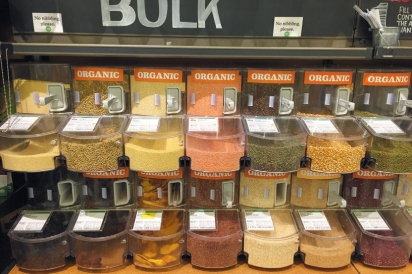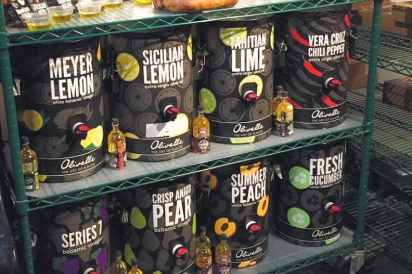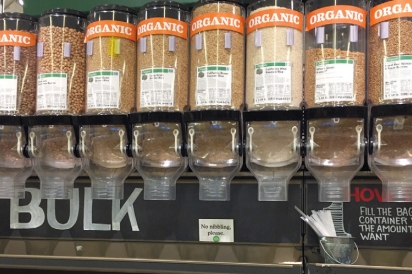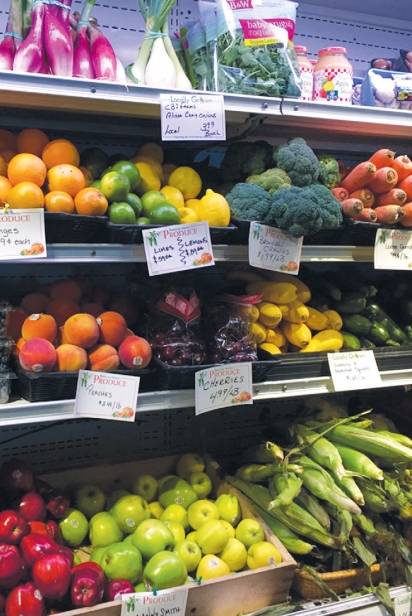Embracing Zero Waste
Joining the ranks of “zero wasters” is challenging. This vision, coined for its mission of leaving as minimal a footprint as possible on the arth, is building global momentum. I stumbled upon the topic about a year ago while surfing through TEDx Talks online. I admired several individuals who fit all the trash they produced in a year into a single mason jar, some with a little room to spare. The contents were small pieces of plastic that were not recyclable, something that resembled a ripped polyester shoelace, and stickers, like the ones on bananas.
One of the most well-known proponents of the movement, Bea Johnson, hails from France but now lives in Mill Valley, California with her husband and two teenagers. Zero Waste Home: The Ultimate Guide to Simplifying Your Life by Reducing Your Waste is her best-selling book on waste-free living. She lectures worldwide, and her dedication, creativity and energy, both in achieving zero waste goals personally and at expounding the movement’s principles, is inspiring.
As a passionate recycler for years—a consignor to local thrift shops, donor to local “gift houses” and clothing drop boxes—I thought my family’s efforts were solid until I discovered devoted zero wasters around the globe. The first glance may appear daunting, but even if we can’t immediately approach absolute zero waste, some very simple changes can be hugely beneficial for both ourselves and our planet.
Because the kitchen is where zero waste efforts can have tremendous impact, and because this is, after all, Edible Cape Cod, the focus of this story is on food, cooking and eating utensils.
Many areas of the world, in particular Europe and Canada, already have numerous shops where people can buy food in bulk—and not just grains, rice and beans. Expansive selections including dairy, bakery items, meats, fish and organic milk in reusable returnable containers are offered along with options to refill your own bottles with shampoo, honey, syrup and even wine.
We all know well the slogan Reduce, Reuse, Recycle, but Johnson has added two more words. The first is Refuse. She encourages us to always consider an object’s total impact before accepting it. This may be the most important takeaway should you choose to begin this journey. Pause and consider if unneeded, unwanted, unusable and perhaps even dangerous things didn’t enter your home to begin with, you would not need to store, care for, and ultimately, dispose of them. As hard as it to do, Johnson strives to reject objects she knows she doesn’t need long-term, even if they are great buys or (gasp) free!
Reduce reminds us to pare down to essentials. Johnson eschews all plastic in her kitchen, using only metal or wood; cookware and utensils are few. Her rationale is that if you have only two hands, how many wooden spoons can you use at a time? Vegetable and surface cleaning brushes are wood, (toothbrushes are bamboo) so that the bristles can be removed when worn, and the handles recycled.
Single-use items like paper napkins, plates and straws are out. Many zero wasters use a matching set of mason jars as drink-ware—they’re glass, affordable, durable and replaceable. In the fridge, perishables reside in metal or glass covered dishes.
Packaging of all types—plastic, paper, films, cardboard, Styrofoam, foils and glass—are avoided whenever possible by bringing and using one’s own containers, wrappings or bags. There is much evidence about the detrimental effects of not only storing and/or heating food in plastic, but with the problems associated with discarding and recycling it after use, which can only occur a limited number of times for different types of plastic. Discarded plastic that enter our landfills and oceans erodes and eventually contaminates our food supply.
The containers of choice for food storage are glass and fabric. Glass can be recycled forever, and natural fabrics, when well worn, will decompose. It’s easy to amass a variety of serviceable jars from one’s own groceries. Reuse the fabric remnants, bedding, and vintage linens you own to stitch up simple bags.
Partially used produce such as half a tomato, cuke or lime, can be stored cut-side down in small ceramic ramekins or glass dishes instead of in plastic wrap or foil. Reusable wrapping sheets made of beeswax are also an option. Bread and simple baked items can be wrapped and frozen in large clean fabric bags, even pillowcases.
Should you choose to invest in jars, the Bentley of glass containers is the Le Parfait and translated, its name means exactly that: perfect. From Reims, France, a city famous for its champagne, these glass metal-hinged jars have been the French chef's treasured choice for food storage since 1930. Glass keeps food fresh without transferring odors, it can be recycled ad infinitum, and shows the contents within. Before researching this piece, I scored one at a recent “free shop” dropoff. Love it!
Browse thrift shops, yard sales and tag sales for reusable jars. Replacements for rubber gaskets in poor condition can easily be found at supermarkets and cook shops or online for a fraction of the cost of entire jars. Many produced abroad are “L” stamped, indicating liters. Be conservative when purchasing until you are sure the contents fit within designated jars. For example, all-purpose, cake and wholewheat flour each have a different density, so each takes up a slightly different volume.
Locating produce and dry goods to fill your bags and jars is trickier than locating the containers, to a large extent because of Massachusetts State health laws. While a local butcher, fishmonger and baker I spoke with all agreed that if requested, they’d plop items into a customer’s container (wearing gloves and weighing on sheets of food-grade tissue as usual), technically they should not.
A brand new self-serve kombucha dispenser stands at the Whole Foods Market in Hyannis, where the customer can decant into a reusable glass bottle purchased at the time of initial fill, but for the most part, this is not the case. An employee explains, “because of regulations, customers are required to purchase bulk items and things like freshly-squeezed orange juice only in the bags and containers Whole Foods provides for them, and for now ours are plastic, but this may change.”
Local breweries are state-mandated not to refill customers’ beer growlers, even ones they have sold, although they’re hoping the restrictions will change. You may locate a small market permitting you to fill your own vessel with self-serve extra virgin oil or flavored balsamic vinegar, but most require purchasing their on-site sterilized bottles.
Happily, at farmers’ markets, cloth bags are already steadily jamming. Weigh your produce, then fill satchels until bursting with beets, beans and radishes. Once at home, pop them right into the fridge or a cool dark pantry (good for root veggies). When empty, toss bags into the laundry. Done! A lovely variety of produce all week. Fortunately, most local whole food stores surveyed offer paper bags, so weighing items has minimal impact. They also carry a nice selection of bulk grains, beans, nuts, granolas, pastas, spices, dried fruits and even specialty treats like organic coconut rolled dates and gummy worms.
Another “R” word Johnson strings to the end of her list, although not as an afterthought, is Rot. She implores you to compost ardently. Begin right now with large yogurt containers under your sink. Stuff them daily with every scrap of veggie and fruit, skins, peels, pulp, roots, cores, seeds and all. House the container within reach and it becomes second nature to grab it. Be sure to pop on the lid when you fill, so there’s no odor, fruit flies, or pests in the kitchen, especially in warm weather.
As you head outside, toss the contents into a composter (which you can purchase at most town disposal areas for about $40). A small area ringed with chicken wire can also serve as an open air compost pile. Either choice would be best placed a bit away from your house as you may attract a few curious four-legged visitors. Layer on some browns (old leaves), some greens (grass clippings) and add some sprinkles on top (red wrigglers, the preferred worms for composting). Repeat. The perfect recipe for compost.
Akin to the Tiny House movement gaining momentum internationally, as people explore zero waste possibilities, they examine what, where, why and how they purchase. Many find their lives simplified, their health improved, and with space to do more of things that matter to them, enjoy spending more time with the people they care about.
Less may truly be more.
Getting Started on Going Zero Waste
TEDx Talks: Two adults, two kids, zero waste | Bea Johnson youtu.be/CSUmo-40pqA
Bea Johnson: zerowastehome.com
Ten Tips for Zero Waste Living: youtu.be/rkyBedvJeQc
10 zero waste bloggers you should know: treehugger.com/green-home/10-zero-waste-bloggersyou- should-know.html
Life Lived Simply Blog: mrscolleenblack.wordpress.com
Local Red Wigglers for sale, plus info on vermicomposting, the technical term for using worms to speed up the decomposition process of compost, and then using their nutrient-laden waste as fertilizer: woosworms.com











